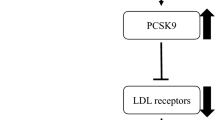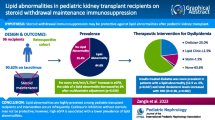Abstract
Genetic variation of ATP-binding cassette subfamily B member 1 (ABCB1) which encodes P-glycoprotein (P-gp) has been associated with lipid levels and response to statins. Here, we studied these associations in patients with advanced heart failure who subsequently underwent transplantation. Fasting total cholesterol (TC), low density lipoprotein (LDL) cholesterol, high density lipoprotein (HDL) cholesterol and triglycerides (TG) concentrations in 268 adult heart transplant recipients were analysed retrospectively before and at 1 year after transplantation (n = 176). ABCB1 genotyping and haplotyping for C1236T, G2677T/A and C3435T was performed using polymerase chain reaction. Pre-transplant LDL cholesterol was found to be associated with the C3435T genotype and the G2677T/A-C3435T and C1236T-G2677T/A-C3435T haplotypes. T-allele carriers at all loci (n = 77) had higher LDL levels than non-T-allele carriers (n = 24, 3.5 ± 1.2 vs. 2.8 ± 1.2 mmol/L, respectively, p = 0.025). This association remained after adjustment for age, sex, body mass index, statin use and underlying ischaemic heart disease. ABCB1 genotype was not associated with post-transplant lipid parameters. Hypercholesterolaemia (TC >5.7 mmol/L) was more prevalent post-transplant than pre-transplant (51% vs. 30%, respectively) and was likely related to steroid and calcineurin inhibitor use. Muscle-related statin effects were only seen in patients possessing the T-haplotype. In conclusion, an association between ABCB1 haplotype and plasma fasting LDL cholesterol concentration was found in patients with advanced heart failure. This association was not seen 1 year after cardiac transplantation.
Similar content being viewed by others
Abbreviations
- ABCB1 :
-
ATP-binding cassette, subfamily B, member 1
- HDL:
-
High density lipoprotein
- LDL:
-
Low density lipoprotein
- MDR1 :
-
Multidrug resistance gene 1
- ns:
-
Non-significant
- PCR:
-
Polymerase chain reaction
- SNP:
-
Single nucleotide polymorphism
- TC:
-
Total cholesterol
- TG:
-
Triglycerides
References
Wenke, K. (2004). Management of hyperlipidaemia associated with heart transplantation. Drugs, 64(10), 1053–1068.
Escobar, A., Ventura, H. O., Stapleton, D. D., Mehra, M. R., Ramee, S. R., Collins, T. J., et al. (1994). Cardiac allograft vasculopathy assessed by intravascular ultrasonography and nonimmunologic risk factors. The American Journal of Cardiology, 74(10), 1042–1046.
Kapadia, S. R., Nissen, S. E., Ziada, K. M., Rincon, G., Crowe, T. D., Boparai, N., et al. (2001). Impact of lipid abnormalities in development and progression of transplant coronary disease: a serial intravascular ultrasound study. Journal of the American College of Cardiology, 38(1), 206–213.
Bilchick, K. C., Henrikson, C. A., Skojec, D., Kasper, E. K., & Blumenthal, R. S. (2004). Treatment of hyperlipidemia in cardiac transplant recipients. American Heart Journal, 148(2), 200–210.
Hosenpud, J. D., Bennett, L. E., Keck, B. M., Boucek, M. M., & Novick, R. J. (2000). The Registry of the International Society for Heart and Lung Transplantation: seventeenth official report—2000. The Journal of Heart and Lung Transplantation, 19(10), 909–931.
Tous, M., Ribas, V., Ferre, N., Escola-Gil, J. C., Blanco-Vaca, F., Alonso-Villaverde, C., et al. (2005). Turpentine-induced inflammation reduces the hepatic expression of the multiple drug resistance gene, the plasma cholesterol concentration and the development of atherosclerosis in apolipoprotein E deficient mice. Biochimica et Biophysica Acta, 1733(2–3), 192–198.
Metherall, J. E., Li, H., & Waugh, K. (1996). Role of multidrug resistance P-glycoproteins in cholesterol biosynthesis. The Journal of Biological Chemistry, 271, 2634–2640.
Rodrigues, A. C., Rebecchi, I. M., Bertolami, M. C., Faludi, A. A., Hirata, M. H., & Hirata, R. D. (2005). High baseline serum total and LDL cholesterol levels are associated with MDR1 haplotypes in Brazilian hypercholesterolemic individuals of European descent. Brazilian Journal of Medical and Biological Research, 38(9), 1389–1397.
Jeannesson, E., Siest, G., Bastien, B., Albertini, L., Aslanidis, C., Schmitz, G., et al. (2009). Association of ABCB1 gene polymorphisms with plasma lipid and apolipoprotein concentrations in the STANISLAS cohort. Clinica Chimica Acta, 403(1–2), 198–202.
Kajinami, K., Brousseau, M. E., Ordovas, J. M., & Schaefer, E. J. (2004). Polymorphisms in the multidrug resistance-1 (MDR1) gene influence the response to atorvastatin treatment in a gender-specific manner. The American Journal of Cardiology, 93(8), 1046–1050.
Chinn, L. W., & Kroetz, D. L. (2007). ABCB1 pharmacogenetics: progress, pitfalls, and promise. Clinical Pharmacology and Therapeutics, 81(2), 265–269.
Salama, N. N., Yang, Z., Bui, T., & Ho, R. J. (2006). MDR1 haplotypes significantly minimize intracellular uptake and transcellular P-gp substrate transport in recombinant LLC-PK1 cells. Journal of Pharmaceutical Sciences, 95, 2293–2308.
Goard, C. A., Mather, R. G., Vinepal, B., Clendening, J. W., Martirosyan, A., Boutros, P. C., Sharom, F. J., Penn, L. Z. (2010). Differential interactions between statins and P-glycoprotein: implications for exploiting statins as anticancer agents. International Journal of Cancer [Epub ahead of print].
Bogman, K., Peyer, A. K., Torok, M., Kusters, E., & Drewe, J. (2001). HMG-CoA reductase inhibitors and P-glycoprotein modulation. British Journal of Pharmacology, 132(6), 1183–1192.
Neuvonen, P. J., Niemi, M., & Backman, J. T. (2006). Drug interactions with lipid-lowering drugs: mechanisms and clinical relevance. Clinical Pharmacology and Therapeutics, 80(6), 565–581.
Keskitalo, J. E., Kurkinen, K. J., Neuvoneni, P. J., & Niemi, M. (2008). ABCB1 haplotypes differentially affect the pharmacokinetics of the acid and lactone forms of simvastatin and atorvastatin. Clinical Pharmacology and Therapeutics, 84(4), 457–461.
Becker, M. L., Visser, L. E., van Schaik, R. H., Hofman, A., Uitterlinden, A. G., & Stricker, B. H. (2009). Common genetic variation in the ABCB1 gene is associated with the cholesterol-lowering effect of simvastatin in males. Pharmacogenomics, 10(11), 1743–1751.
Fiegenbaum, M., da Silveira, F. R., Van der Sand, C. R., Van der Sand, L. C., Ferreira, M. E., Pires, R. C., et al. (2005). The role of common variants of ABCB1, CYP3A4, and CYP3A5 genes in lipid-lowering efficacy and safety of simvastatin treatment. Clinical Pharmacology and Therapeutics, 78(5), 551–558.
Olerup, O., & Zetterquist, H. (1992). HLA-DR typing by PCR amplification with sequence-specific primers (PCR-SSP) in 2 hours: an alternative to serological DR typing in clinical practice including donor-recipient matching in cadaveric transplantation. Tissue Antigens, 39(5), 225–235.
Taegtmeyer, A. B., Breen, J. B., Smith, J., Burke, M., Leaver, N., Pantelidis, P., et al. (2010). ATP-binding cassette subfamily B member 1 polymorphisms do not determine cyclosporin exposure, acute rejection or nephrotoxicity after heart transplantation. Transplantation, 89(1), 75–82.
Friedewald, W. T., Levy, R. I., & Fredrickson, D. S. (1972). Estimation of the concentration of low-density lipoprotein cholesterol in plasma, without use of the preparative ultracentrifuge. Clinical Chemistry, 18(6), 499–502.
Kroetz, D. L., Pauli-Magnus, C., Hodges, L. M., Huang, C. C., Kawamoto, M., Johns, S. J., et al. (2003). Sequence diversity and haplotype structure in the human ABCB1 (MDR1, multidrug resistance transporter) gene. Pharmacogenetics, 13(8), 481–494.
Cascorbi, I., Gerloff, T., Johne, A., Meisel, C., Hoffmeyer, S., Schwab, M., et al. (2001). Frequency of single nucleotide polymorphisms in the P-glycoprotein drug transporter MDR1 gene in white subjects. Clinical Pharmacology and Therapeutics, 69(3), 169–174.
Rauchhaus, M., Clark, A. L., Doehner, W., Davos, C., Bolger, A., Sharma, R., et al. (2003). The relationship between cholesterol and survival in patients with chronic heart failure. Journal of the American College of Cardiology, 42(11), 1933–1940.
Wedel, H., McMurray, J. J., Lindberg, M., Wikstrand, J., Cleland, J. G., Cornel, J. H., et al. (2009). Predictors of fatal and non-fatal outcomes in the Controlled Rosuvastatin Multinational Trial in Heart Failure (CORONA): incremental value of apolipoprotein A-1, high-sensitivity C-reactive peptide and N-terminal pro B-type natriuretic peptide. European Journal of Heart Failure, 11(3), 281–291.
Berry, C., & Clark, A. L. (2000). Catabolism in chronic heart failure. European Heart Journal, 21(7), 521–532.
Akhlaghi, F., Jackson, C. H., Parameshwar, J., Sharples, L. D., & Trull, A. K. (2002). Risk factors for the development and progression of dyslipidemia after heart transplantation. Transplantation, 73(8), 1258–1264.
Ballantyne, C. M., Radovancevic, B., Farmer, J. A., Frazier, O. H., Chandler, L., Payton-Ross, C., et al. (1992). Hyperlipidemia after heart transplantation: report of a 6-year experience, with treatment recommendations. Journal of the American College of Cardiology, 19(6), 1315–1321.
Kobashigawa, J. A., Katznelson, S., Laks, H., Johnson, J. A., Yeatman, L., Wang, X. M., et al. (1995). Effect of pravastatin on outcomes after cardiac transplantation. The New England Journal of Medicine, 333(10), 621–627.
Kathiresan, S., Willer, C. J., Peloso, G. M., Demissie, S., Musunuru, K., Schadt, E. E., et al. (2009). Common variants at 30 loci contribute to polygenic dyslipidemia. Nature Genetics, 41, 56–65.
Keskitalo, J. E., Kurkinen, K. J., Neuvonen, M., Backman, J. T., Neuvonen, P. J., & Niemi, M. (2009). No significant effect of ABCB1 haplotypes on the pharmacokinetics of fluvastatin, pravastatin, lovastatin, and rosuvastatin. British Journal of Clinical Pharmacology, 68(2), 207–213.
Moghadasian, M. H. (2002). A safety look at currently available statins. Expert Opinion on Drug Safety, 1(3), 269–274.
Penninga, L., Moller, C. H., Gustafsson, F., Steinbruchel, D. A., & Gluud, C. (2010). Tacrolimus versus cyclosporine as primary immunosuppression after heart transplantation: systematic review with meta-analyses and trial sequential analyses of randomised trials. European Journal of Clinical Pharmacology, 66(12), 1177–1187.
Cummins, C. L., Jacobsen, W., & Benet, L. Z. (2002). Unmasking the dynamic interplay between intestinal P-glycoprotein and CYP3A4. The Journal of Pharmacology and Experimental Therapeutics, 300(3), 1036–1045.
Link, E., Parish, S., Armitage, J., Bowman, L., Heath, S., Matsuda, F., et al. (2008). SLCO1B1 variants and statin-induced myopathy—a genomewide study. The New England Journal of Medicine, 359(8), 789–799.
Niemi, M. (2010). Transporter pharmacogenetics and statin toxicity. Clinical Pharmacology and Therapeutics, 87(1), 130–133.
Funding Sources
This work was supported by Magdi Yacoub Institute and the Royal Brompton, the Harefield NHS Trust Clinical Research Committee and the National Institutes of Health Research Cardiovascular Biomedical Research Unit at the Royal Brompton and Harefield NHS Foundation Trust and Imperial College.
Author information
Authors and Affiliations
Corresponding author
Rights and permissions
About this article
Cite this article
Taegtmeyer, A.B., Breen, J.B., Smith, J. et al. Effect of ABCB1 Genotype on Pre- and Post-Cardiac Transplantation Plasma Lipid Concentrations. J. of Cardiovasc. Trans. Res. 4, 304–312 (2011). https://doi.org/10.1007/s12265-011-9269-z
Received:
Accepted:
Published:
Issue Date:
DOI: https://doi.org/10.1007/s12265-011-9269-z




